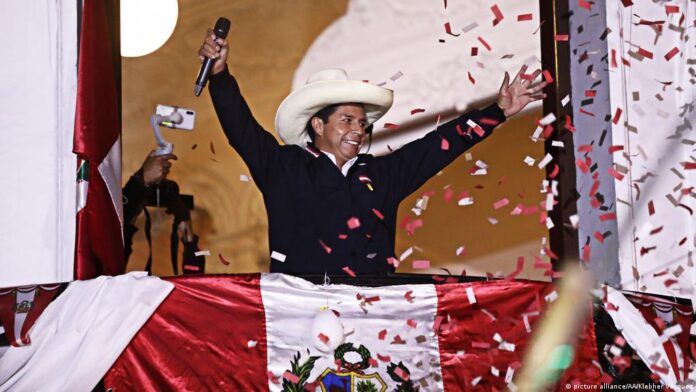No concessions to capital! Build mass mobilisation for radical change
Marcos Ariel, ISA supporter in Argentina
The deep economic crisis, the great social polarization and the radicalization of the poorest sectors in Peru were expressed in the presidential elections with the triumph of the rural teacher and candidate for the ‘Peru Libre’ party, Pedro Castillo against the ultra-right neo-liberal candidate, Keiko Fujimori.
This triumph is a blow not only to all the Peruvian right-wing parties but also to the projects of the right wing throughout the continent. It also adds to the radical turn and process of massive struggle that Latin America is experiencing with the constituent election in Chile after the popular insurrection of 2019 and the great struggle of the Colombian people against the government of Ivan Duque.
The elections were held not only in the midst of the pandemic that hit the country very hard, with its very precarious health system after decades of neoliberalism, but also in the midst of a great institutional crisis and discrediting of the traditional parties. This was expressed in a huge electoral atomization in the first round with 18 candidates running for president, and in which an unknown Pedro Castillo surprised many by finishing in first place.
His election is a product of the weariness with traditional politicians and the status quo and a result of the dynamics opened by the massive mobilizations in Peru in 2020. With his proposals for radical change, such as convening a constituent assembly to replace the 1993 neoliberal constitution, the nationalization of key industries, a second agrarian reform, allocating a large part of the GDP to health and education as well as the distribution of wealth (“no more poor people in a rich country” was his campaign slogan), in addition to a simple speech and an image of a “humble man”, Castillo knew how to reach into the “deep Peru” made up of peasants and indigenous people, historically relegated and condemned to live in poverty.
In rural and jungle areas he won overwhelmingly. For example in Apurimac region, he won with 81.4% against Keiko’s 18.5%, the same in Ayacucho by 82.2% to 17.7%, and also in Cusco, Arequipa, etc. However, his victory also represented the indignation of other popular sectors such as the increasingly impoverished workers in the cities.
In the second round, he was boosted by the profound rejection of ‘Fujimorismo’ (Keiko is daughter and political heir of Alberto Fujimori, former dictator) that was expressed in the #NOAKEIKO movement. He also won the support of Verónica Mendoza of Juntos por el Perú (another Left candidate who had run in the first round), the Frente Amplio and other organizations of the left, as well as the trade unions.
Capitalists — Surprised, then frightened
The bourgeoisie was at first surprised and then frightened. It orchestrated a campaign of fear in the second round, installing a true “politics of terror” with which they sought to frighten the population. With a barrage of attacks of the style that if Castillo wins “the communists will take your house”. They even used the massacre perpetrated in the Vraem region (an area dominated by drug trafficking groups) to try to smear Castillo. This McCarthyist campaign was promoted by all the major media outlets that went so far as to fire journalists who refused to campaign for Keiko.
They also wanted to instill the idea that Keiko Fujimori represented the defense of democracy, against the communist Pedro Castillo. As soon as the election was over, they maneuvered by publishing an exit poll naming Keiko as the winner. But they failed miserably. The millions spent were not enough to twist the will of a people fed up with right-wing governments and determined to use the elections to impose a political change.
Victory a product of mass mobilisation
Faced with the crisis which was opened by mass mobilizations in November 2020 which brought down the illegitimate President Manuel Merino, the bourgeoisie responded by calling presidential elections for 2021, seeking in this way to divert the people’s anger and end the crisis. But they did not take into account that the people not only wanted a change of president but also a change to the system. This is why we consider Castillo’s electoral triumph to be a product of those mobilizations. Although it is not a direct result of mass action, it expresses the continued search of the masses for a radical change by voting for the candidate who had the most radical proposals.
The mobilization did not end with the elections, but continued in another way in the massive campaign rallies of Pedro Castillo. Also on the very Sunday of the election, not only did people go massively to vote, but also once the voting was closed and faced with the possibility of electoral fraud to impose Keiko, there was a spontaneous march towards the vote counting office. This mobilization continued in the following days until Castillo’s triumph seemed guaranteed. Maintaining this willingness to mobilize (yesterday to throw out one president, today to put in another) can be the only guarantee that Castillo will comply with the radical measures promised.
Let us remember that the Peruvian people had an experience with former President Hollanta Humala, which raised hope among millions but ended in disappointment. The difference is that now Castillo will govern in the midst of a global crisis where he does not have much economic room for maneuver. Either he quickly makes the promised political and economic changes or his government will be in crisis even more quickly than Humalla’s, especially since he governs thanks to mass mobilization.
No concessions! Build mass mobilisation for radical change
Unfortunately, the first signals point in a disappointing direction. Castillo’s statements are aimed at calming the bourgeoisie by “maintaining dialogue with the various sectors of businessmen” and indicating that his government will respect private property and even that all the changes he will make will be within the current constitution.
We have heard similar noises from Castillo’s advisers, such as Pedro Francke, who repeatedly stated that “we have not contemplated in our economic plan nationalizations, expropriations, the confiscation of savings, currency exchange controls, price controls or prohibitions of imports” or Andres Alencastre, who stated that the planned agrarian reform does not contemplate land expropriations.
The economic model promoted by Pedro Castillo which has been called a “popular economy with markets” and does not interfere with the interests of the multinationals and national big business will benefit the market more than the people. As well-known Peruvian socialist Carlos Mariátegui said “the national bourgeoisies see in cooperation with imperialism the best source of their profits”.
Along with these important political limitations, it is necessary to point out and criticize the very problematic positions that Castillo has defended in relation to fundamental issues such as the right to free abortion and LGBT+ marriage (he has openly opposed both). Only by understanding the need to defend and bring together the legitimate demands of all the oppressed, around a program to transform society, will it be possible to build a new society.
Castillo’s triumph means a step forward for popular aspirations and opens the possibility of implementing great changes. But for this to happen, he must not give in to or trust the bourgeoisie or imperialism, as Che Guevara used to say “not even a little bit”. That is why his first measure must be to call for a revolutionary constituent assembly to bury the old neoliberal constitution. This was a main demand that emerged from the November 2020 protests and would be an opportunity for the peasants, indigenous people, workers, the feminist movement, LGBT rights movement and all sectors or the workers’ movement to have a voice and a vote in a new Constitution.
But we must also fight for the necessary economic changes such as the nationalization of all the strategic sectors of the economy that are in the hands of the bourgeoisie and to operate them under workers’ control. This is the only way to guarantee a true distribution of wealth that means more jobs, health and education. And also to put an end to the extractivist production model that pollutes and plunders nature.
The situation in Peru presents revolutionaries with enormous challenges and opportunities to build a real left organization which, without sectarianism but also without opportunism, will promote popular mobilization, the unity of the working class and the mass movements. Such a left will wage political struggle not only against the right wing but also against reformist sectors which do not want to promote radical changes. All the energy of the Peruvian masses must be organized to advance beyond the reforms proposed by Pedro Castillo. It must go towards the destruction of this capitalist state and advance in the construction of a workers’ government and build socialism in Peru and the rest of Latin America. Our international organization ISA (International Socialist Alternative) is fully in the service of this exciting task.




